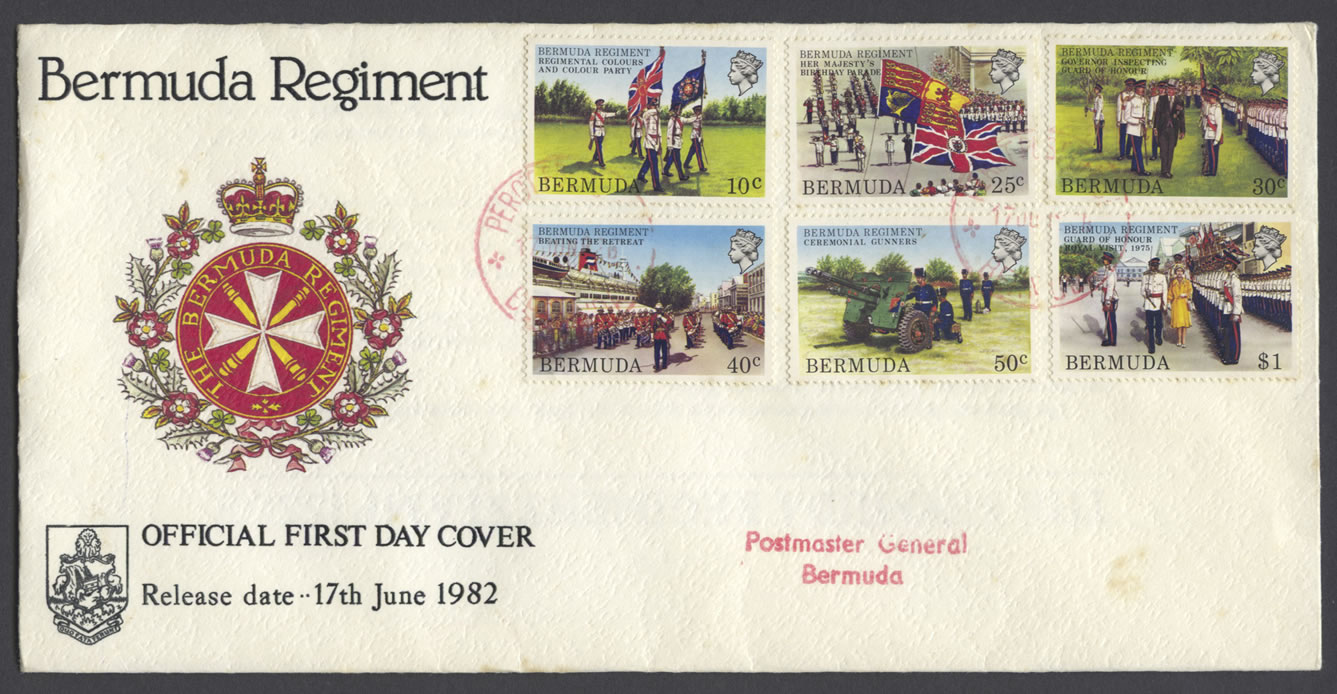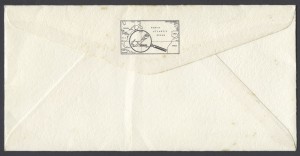Your basket is currently empty!

1982 Bermuda Regiment
Commemorating the Bermuda Regiment
Date: 17th June 1982
Stamps: Bermuda Regiment 10c Regimental Colours and Colour Party; 25c Her Majesty’s Birthday Parade; 30c Governor Inspecting Guard of Honour; 40c Beating the Retreat; 50c Ceremonial Gunners and $1 Guard of Honour Royal Visit, 1975
Type: Official First Day Cover
CDS: 17JUN82B PEROT POST OFFICE BERMUDA
Cachet: Bermuda Regiment OFFICIAL FIRST DAY COVER Release date 17th June 1982
Address: Postmaster General Bermuda
THE BERMUDA REGIMENT STAMP ISSUE
The Bermuda Regiment was formed on 1st September, 1965, as a result of the amalgamation of the Bermuda Militia Artillery and Bermuda Rifles.
The Bermuda Militia Artillery was formed under an Act of Colonial Parliament in 1892 and enlistment began in 1895. Records show that the first drill took place on 15th June, 1896.
In the First World War two contingents totalling 250 men of all ranks served in France & Belgium. During the Second World War the unit was embodied and manned the Examination Battery at St. David’s, and later the Battery at Warwick Camp until they were demobilised in 1946.
In 1944, 5 officers and 100 other ranks joined the Caribbean Regiment and served with that unit in Italy and Egypt.
In July 1892 an Act, passed by the Bermuda Legislature, authorized the creation of a force of 300 men for local defence. The actual formation took place in 1895 when the Bermuda Volunteer Rifle Corps was formed.
In 1897 the unit sent a small contingent to England for the celebration of the Diamond Jubilee of Her Majesty Queen Victoria.
During the First World War the BVCR sent two volunteer contingents to serve with the Lincolnshire Regiment. It is believed that the first contingent, which arrived in France in June 1915, was the first Colonial Volunteer contingent to reach French soil. Of the 122 men who served with the Lincolns, 40 died on active service, 16 gained commissions, one received an O.B.E. and six the Military Medal.
In 1929 His Majesty King George V was pleased to approve the affiliation of the BVCR with the Lincolnshire Regiment. As a result of amalgamations in England the Bermuda Regiment is now affiliated to the Royal Anglian Regiment of which the old Royal Lincolns form a part.
During the Second World War two contingents totalling 100 men of all ranks served with the Lincolnshire Regiment. They fought with the Lincolns through the campaigns in North West Europe and in Burma.
The BVCR was demobilised in 1946 but continued with a skeleton Headquarters until 1951.
In 1951, under the Defence Local Forces Act 1949, both units were reformed under the central command of Headquarters Local Forces. The Bermuda Militia Artillery retained its original name but the BVCR was succeeded by the Bermuda Rifles. Both units retained their seperate identities and their own bands.
Conscription was introduced for the Bermuda Rifles in 1957 and for the Bermuda Militia Artillery in 1960.
During recent years both units have combined for ceremonial duties and under the Defence Act 1965 the units were amalgamated to form the Bermuda Regiment.
On the 24th November, 1965, in an impressive ceremony at the National Stadium, Her Royal Highness The Princess Margaret presented the Regiment with its colours.
The Regiment is currently 700 strong made up of volunteers and conscripts who serve for 3 years. A small body of permanent staff work full time to provide the administrative and training back up for the Regiment.
The Regiment has a primary function to provide assistance to the police in matters of internal security. It does however, retain a colourful ceremonial responsibility for four major parades each year in Bermuda.
In December 1978, the Regiment received their first group of voluntary service women. During the briefing on their duties, the Commanding Officer informed them that they would be subject to the same military law as the men.
10 Cent Stamp THE REGIMENTAL COLOURS
The Queen’s Colours and the Regiment Colours are carried by Ensigns with a Warrant Officer in the centre and two Escorts to the Colours; Silver tips are placed over the Bayonets to protect the colours; The Crown and Lion is positioned on the top of the Flag Staffs.
25 Cent Stamp QUEEN’S BIRTHDAY PARADE
Usually performed on the 2nd Monday in June at the Flag Pole, and by far the largest Parade ofthe year. The Governor is greeted on arrival and the Parade forms in Order for the Symbolic arrival of the Queen. The Queen’s Standard is raised as the Governor’s Standard is lowered. The groups then fire a “feu-de-Joie”. The Symbolic departure of Her Majesty is depicted by the lowering of Her Standard.
The Governor then departs as the Parade marches off to the beat of the Regiment Band.
30 Cent Stamp WELCOMING CEREMONY OF THE GOVERNOR
One of the many ceremonies performed by the Bermuda Regiment on the arrival of H.E. The Governor in the Cabinet grounds, Hamilton. The Regiment provides a Guard of Honour, and the Premier as well as other dignitaries are present to greet the new Governor. The Governor is escorted by the Guard Commander and followed by the Commanding Officer of the Regiment and the Aide-de-camp. A similar ceremony is performed by the Regiment at the opening and closing of Parliament.
40 Cent Stamp BEATING-the-RETREAT
Usually performed during the summer months and always with the back drop of the Cruise Ships, the march past and Salute is taken by the Commanding Officer at the Flag Pole on Front Street, Hamilton.
50 Cent Stamp CEREMONIAL GUNNERS
The Regiment has two 25-pounders which are fired on Ceremonial occasions such as, (1) Queen’s Birthday, (2) Rememberance-Day – Fired at 11 ‘o’clock. At the start of the observance of two minutes silence and at the end of the two minutes silence – a single round on each occasion. (3) Governor’s state visit to St. George’s for the Peppercorn Ceremony where 17 shots are fired on the arrival of the Governor.
$1.00 Stamp INSPECTING HONOUR GUARD
The Queen inspecting the Guard of Honour on Front Street during a Royal Visit in 1975 is accompanied by the Guard Commander followed by the Queen’s Equerry.
TECHNICAL DETAILS
Designer: Gordon Drummond
Printer: The House of Questa
Process: Lithography
No of stamps per sheet: 50 (2 x 25)
Stamp size: 28.45 x 42.58 mm
Paper: Slaters Process
Watermark: CA Spiral
Release date: 17 June 1982
by



Leave a Reply
You must be logged in to post a comment.